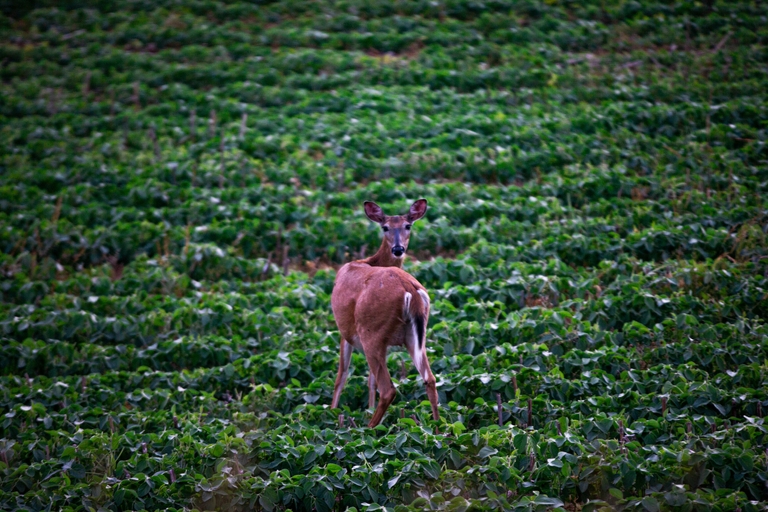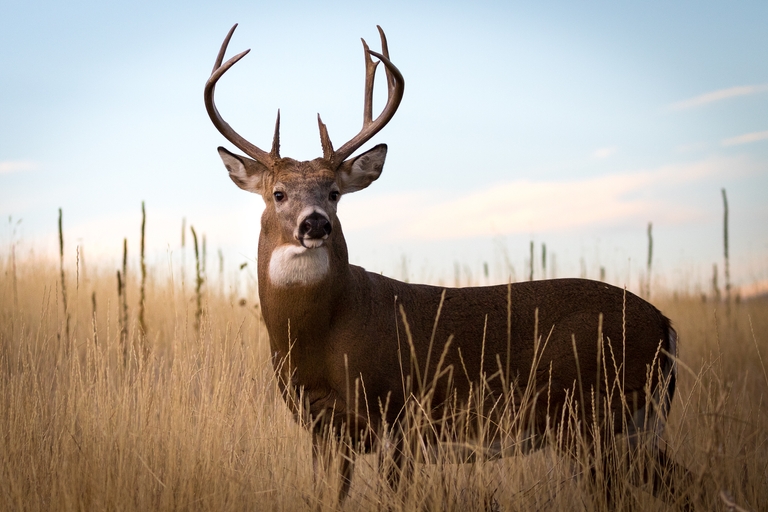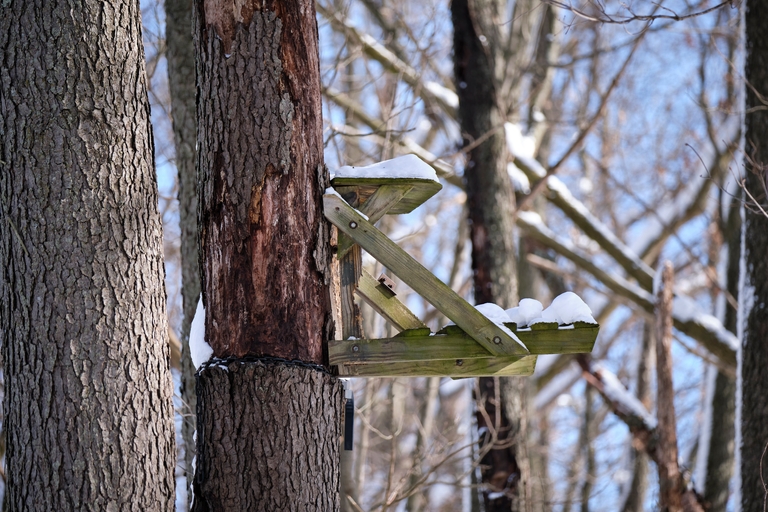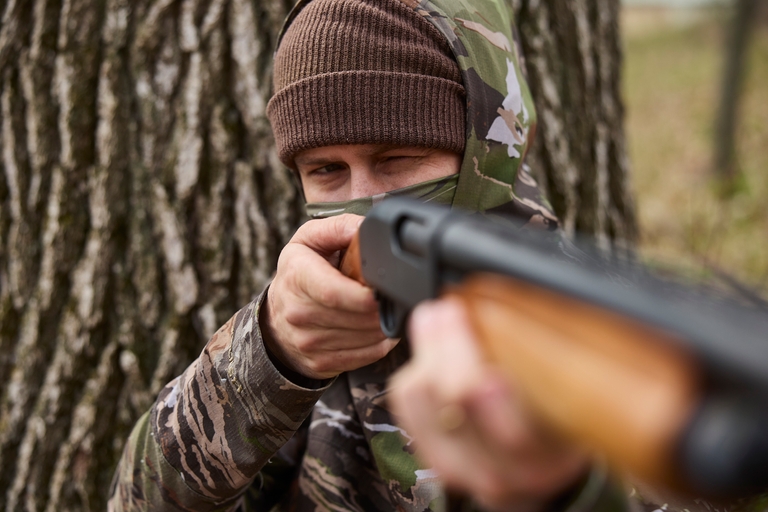Blaze Orange Regulations for Every State

Wearing blaze orange, also known as "fluorescent" or "hunter" orange, is required when hunting in most states. Blaze orange keeps you safe in the field by ensuring you are visible to other hunters.
How much orange do you need to wear? Are there any states that don't require it? Whether you are a new or seasoned hunter, check your state regulations before you hit the woods every season to keep up with regulation changes for wearing orange.
Even when not required, wearing blaze orange is always a good idea. While deer can't see it, other hunters can – and wearing it could save your life!
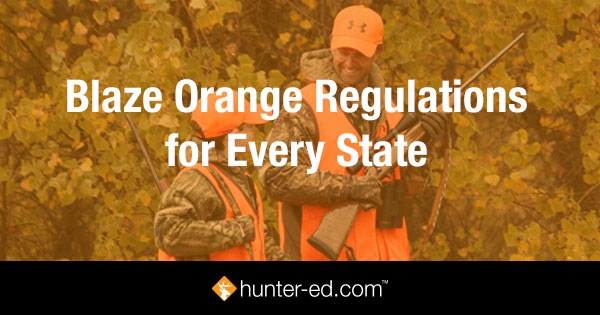
Do I Need to Wear Blaze Orange In My State?
Again, checking your state's regulations before opening day each season is always smart. However, here's an overview of the requirements for each state.
Alabama
All hunters must wear an outer garment above the waist with at least 144 square inches of hunter orange above the waist or a hunter orange hat during firearm seasons for deer, elk, and bear. However, hunters do not need to wear hunter orange when hunting turkey, fox, raccoon, opossum, or migratory birds.
Hunter orange is also not required when hunting from an elevated position of at least 12 feet from the ground. Before hunting, check with the Alabama Department of Conservation and Natural Resources for specifics.
Alaska
Hunter orange is not required in Alaska, but it is strongly encouraged. Wearing orange can significantly reduce the potential for hunting accidents.
Arizona
In Arizona, Hunter orange is not required, but we strongly recommend wearing it when hunting with or near others. Safety must always be a priority throughout any hunting season.
Arkansas
During big game firearm seasons (deer, bear, or elk), hunters must wear at least 400 square inches of hunter orange above the waist, as well as a blaze orange or hunter safety green hat.
At least 144 square inches of blaze orange is also required on each visible side of ground blinds. However, hunters are not required to wear orange when hunting migratory birds.
California
Hunters are not required to wear orange when hunting in California. However, (again) we strongly encourage it.
Colorado
During firearm seasons, Colorado hunters of deer, elk, or antelope must wear at least 500 square inches of solid daylight fluorescent orange above the waist, including a head covering.
However, bowhunters are not required to wear blaze orange during archery-only seasons.
Connecticut
Anyone hunting from Sept. 1 through the end of February in Connecticut must wear at least 400 square inches (about the size of four sheets of paper) of blaze orange above the waist and visible from all sides. This can include a hat and a vest.
However, archery deer hunters are not required to wear orange during archery-only seasons. Additionally, hunters are not required to wear orange when hunting waterfowl from a boat.
Other exemptions exist for hunters in Connecticut, so be sure to check the latest state requirements.
Delaware
Firearm, small game, and bowhunters in Delaware must wear at least 400 square inches of blaze orange on the head, chest, and back during firearm season. However, waterfowl hunters do not have to wear orange.
Florida
When hunting on public land, all Florida deer hunters and their hunting partners must wear at least 500 square inches of fluorescent orange above the waist. However, bowhunters are not required to wear blaze orange during archery-only seasons.
These rules do not apply when hunting on private land. Blaze orange is optional (but strongly recommended).
Georgia
Georgia law requires deer, bear, and feral hog hunters and their companions to wear at least 500 square inches of hunter orange above the waist during firearm deer seasons. This can include orange headwear.
However, orange is not required for archery-only seasons.
Hawaii
All those hunting or accompanying hunters (even if you're not hunting) in public areas in Hawaii must wear a solid blaze orange shirt, vest, coat, or jacket.
The orange must be visible from the front and back while carrying game or wearing a backpack. Check state requirements to learn about certain exceptions.
Idaho
Blaze orange is not required when hunting in Idaho. However, we recommend wearing it to identify game targets vs. non-game targets safely.
Illinois
Illinois hunters of all game must wear 400 square inches of blaze (orange or pink) inches and a hat during firearm deer season. Upland game hunters must wear a blaze orange hat. However, camouflage orange or pink does not meet the requirements.
Keep wearing your orange garments when tracking a wounded deer.
Indiana
When hunting deer, small mammals, pheasants, and quail in Indiana, hunters and bowhunters must wear a blaze orange jacket, vest, hat, or coveralls.
However, bowhunters are not required to wear blaze orange during the archery-only season.
Iowa
When hunting upland game birds, you must wear a hat or cap that is 50% blaze orange. When hunting deer with a firearm, you must wear at least one item – other than a hat – that is blaze orange.
Additionally, when hunting deer while using a blind, you must place at least 144 square inches of blaze orange material on your blind.
Kansas
Big game hunters in Kansas and their companions must wear at least 200 square inches of blaze orange, visible from all directions. Hunters must also wear a blaze orange hat with 50% visibility from any direction.
Camouflage orange does not count toward this requirement.
Kentucky
During deer or elk season, all hunters (and anyone accompanying hunters) in Kentucky must wear solid blaze orange as an outer garment on the head, chest, and back. However, waterfowl and turkey hunters are exempt.
Louisiana
During open deer firearm season, Louisiana hunters must wear at least 400 square inches of hunter orange on their head, chest, and back.
When hunting on private land, hunters may wear a blaze orange hat instead. The orange requirements don't apply to hunters in deer stands on legally posted private lands or archery hunters. More requirements apply for wildlife management areas and dog seasons for rabbits and squirrels.
However, we recommend checking the state's requirements before your hunt.
Maine
During open deer firearm season, Maine hunters must wear two articles of solid blaze-orange clothing visible from all sides. These can include a hat and a jacket, vest, coat, or poncho.
Moose hunters in the moose district must wear one piece of solid blaze-orange clothing.
Maryland
All Maryland hunters and their companions must wear a solid blaze orange hat and a vest or jacket with at least 250 square inches of blaze orange or pink on the front and back.
An outer garment at least 50% hunter orange can substitute for the vest or jacket. Exceptions apply, so check state requirements for the latest details.
Massachusetts
During firearm seasons in Massachusetts, hunters must wear at least 500 square inches of fluorescent orange on the chest, back, and head. Additionally, hunters on WMA land must wear a hunter-orange hat during pheasant and quail season.
As with many states, exceptions apply to orange garment requirements. So, check the latest state requirements for details to gear up appropriately for your hunt.
Michigan
Officials recommend wearing as much hunter as possible in the field for any season. This should include orange outer garments, like a hat, jacket, vest, or rain gear.
Blaze orange should be visible from all sides and must be at least 50 percent orange to meet legal requirements.
Minnesota
During open firearm deer season, hunters and trappers in Minnesota must wear blaze orange on a cap, jacket, vest, shirt, or similar. However, when it's not firearm or muzzleloader season, at least one article of clothing must be hunter orange or pink and worn above the waist to take small game.
Camouflage pink and orange are allowed but must be at least 50 percent pink or orange. Check the latest state requirements for details and other exceptions.
Mississippi
During firearm season, Mississippi deer or hog hunters must wear at least 500 square inches of hunter orange visible from all sides. The orange must be solid (unbroken).
When hunting rabbits or quail, hunters must wear a hunter-orange cap or vest.
Missouri
Missouri law requires the hunter orange color to be plainly visible from all directions during firearms deer hunting seasons. The most important clothing choices are a hunter orange hat and hunter orange outerwear – i.e., a shirt, vest, or jacket.
However, exceptions apply to archery hunting, migratory birds, and small game hunting. Check Missouri's state requirements for details.
Montana
Montana law requires that all big game hunters and anyone accompanying a hunter must have at least 400 square inches of hunter-orange material above the waist visible at all times. A blaze orange hat or cap alone does not meet state requirements.
Violating these requirements can result in a fine.
Nebraska
All big game hunters and bowhunters in Nebraska must wear at least 400 square inches of blaze orange on the head, back, and chest during firearm deer season.
While it's not required for upland game hunters, we strongly encourage wearing blaze orange during your hunt.
Nevada
Blaze orange is not required when hunting in Nevada, but we recommend wearing it. Throw on a hat or a vest to make yourself more visible to other hunters.
New Hampshire
New Hampshire doesn't require hunters to wear blaze orange, but officials strongly recommend wearing it. Wear a cap or vest to help other hunters see you in the field.
New Jersey
All deer, game bird, and small mammal hunters using firearms in New Jersey must wear a blaze orange hat or another item with at least 200 square inches of blaze orange visible from all sides. A camouflage orange hat does not meet the requirements.
Exceptions apply to hunters of waterfowl and wild turkeys as well as bowhunters. So, be sure to check the latest state regulations when preparing for your hunt.
New Mexico
Hunters on White Sands Missile Range must wear at least 244 square inches of blaze orange. Likewise, hunters on Fort Bliss or McGregor military reservations must wear a blaze orange hat and vest.
However, when hunting anywhere else that it's legal to hunt within New Mexico, hunter orange is not required – but is strongly recommended for a safe hunt.
New York
Anyone hunting big game with a firearm or accompanying someone hunting big game with a firearm must wear a solid or patterned fluorescent orange or fluorescent pink hat, vest, or jacket.
Other requirements may apply, so check the state's latest regulations before your hunt.
North Carolina
North Carolina hunters after prey other than foxes, bobcats, raccoons, opossums, or turkeys with a firearm must wear a fluorescent orange hat or outer garment visible from all sides. However, blaze orange isn't required for landowners or their spouses and children when hunting on their own property.
North Dakota
Big game hunters and those hunting during firearm seasons in North Dakota must wear at least 400 square inches of blaze orange with a hat and garment above the waist. A camouflage garment does not meet this requirement.
Ohio
During deer season or primitive season in Ohio, hunters must wear a blaze orange vest, coat, jacket, or overalls when hunting from 30 minutes before sunrise until 30 minutes after sundown. This applies to hunting on public and private land.
However, waterfowl hunters are an exception.
Oklahoma
Oklahoma deer, elk, or antelope hunters who use firearms must wear at least 400 square inches of blaze orange as an outer garment above the waist and a hat. During open firearm deer season, all hunters must follow these requirements.
During any firearms season, archery hunters must wear a blaze orange head covering or outer garment above the waist. Camouflage orange garments are legal if they have 400 square inches of hunter orange.
For other exceptions, visit the state's website for the latest information.
Oregon
In Oregon, hunters under 17 years old must wear fluorescent orange visible from all directions as a shirt, jacket, coat, vest, sweater, or head covering when hunting game mammals or upland birds with a firearm.
However, all hunters are encouraged to wear hunter orange during any hunt.
Pennsylvania
During Pennsylvania's regular firearm deer season, hunters must wear at least 250 square inches of hunter orange on their heads, chests, and backs. This rule also applies to special archery deer season hunters when the archery season coincides with the general season for turkey or small game.
Additionally, hunters must display a minimum of 100 square inches of hunter orange within 15 feet of a blind or enclosed tree stand.
Other requirements apply to groundhog and spring turkey hunters, so check the state's requirements for information.
Rhode Island
All hunters (and the general public using hunting lands during hunting season) in Rhode Island must wear at least 500 square inches of fluorescent orange above the waist and visible from all sides. This can be a combination of a hat and vest, equalling 500 square inches of solid hunter orange.
Consult the state's latest information for additional requirements that can vary by season and type of game.
South Carolina
When hunting deer, bear, and hogs on WMA (wildlife management areas) land in South Carolina, hunters must wear a hat, coat, or vest of solid international (or "blaze") orange when hunting during any gun and muzzleloader season.
Exemptions apply for dove, turkey, waterfowl, and migratory bird hunters. Check with the state for details.
South Dakota
All big game firearm hunters (excluding turkey and mountain lion) in South Dakota must wear at least one hunter-orange garment above the waist. Acceptable garments include hats, vests, shirts, jackets, coats, or sweaters.
Camouflage garments do not count toward the requirement.
Tennessee
Tennessee hunters must wear at least 500 square inches of blaze orange on their head or upper portion of their body, visible from front and back. This can include camouflage orange garments containing 500 square inches of orange.
Hunter orange is required during the August Hunt in Unit CWD. However, other exceptions can apply. Check the latest state requirements before planning your hunt.
Texas
On any public hunting lands, including National Forests and grasslands in Texas, hunters and their companions must wear at least 144 square inches of blaze orange on the chest and back. Hunters must also wear at least 400 inches of blaze-orange headgear.
Exceptions apply to turkey, migratory birds, desert bighorn sheep, and alligator hunters.
Utah
Currently, during centerfire rifle hunting in Utah, hunters must wear at least 400 square inches of hunter orange on the head, chest, and back. However, proposed legislation could reduce that requirement to just one hunter-orange piece of outerwear, like a vest, jacket, or hat.
To stay up to date on that legislation and any current exceptions apply, see Utah official sites for details.
Vermont
Blaze orange is not required in Vermont, but it could save your life. We highly recommend wearing it during your hunt.
Virginia
During firearm deer season, Virginia hunters (and anyone accompanying them during a hunt) must wear hunter orange on the upper body or a hunter orange hat visible from all sides.
Alternatively, hunters may display 100 square inches of hunter orange within body reach, at or above shoulder level, and visible from all sides.
Washington
A minimum of 400 square inches of blaze or "hunter" orange or pink worn above the waist and visible from all sides is required in Washington. A hat alone does not meet this requirement.
Firearm hunters and those hunting deer or elk during firearm seasons must use hunter orange. However, when hunting upland game or using a bow, hunter orange or pink is not a requirement.
Check with the state for more details about exceptions.
West Virginia
During deer gun season, all West Virginia deer hunters must wear an outer garment with at least 400 square inches of blaze orange.
However, wearing hunter orange is not required if you're hunting on your own land.
Wisconsin
During firearm deer season in Wisconsin, hunters must wear at least 50% hunter orange or pink as outer garments above the waist, including head coverings. However, waterfowl hunters are exempt from this rule.
Wyoming
Wyoming big game hunters must wear at least one fluorescent orange piece, such as a vest, jacket, or coat. Only licensed archery hunters are exempt at certain times of year.
Small game and bird hunters must wear blaze orange when pheasant hunting in a WMA or on lands bordering Glendo State Park. Additionally, the state recommends that all hunters wear blaze orange or pink when hunting.
Wear Blaze Orange and Take a Hunter Safety Course to Stay Safe
Remember: hunter orange or pink requirements can change for your state between hunting seasons. Always check the latest recommendations or requirements so you can gear up properly before your next hunt!
Make sure you've also taken a state-approved hunter safety course. Many states require this course (along with the proper hunter-orange clothing) to hunt legally. Find your state course, create an account, and then start learning about firearm safety, how blaze orange helps keep hunters safe, and regulations and ethics for hunting.
Originally published December 18, 2015. Content updated December 4, 2023.

